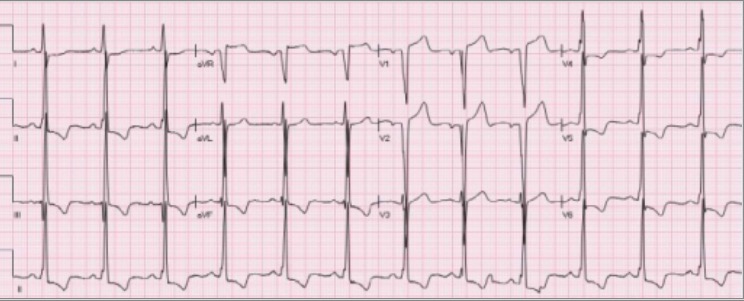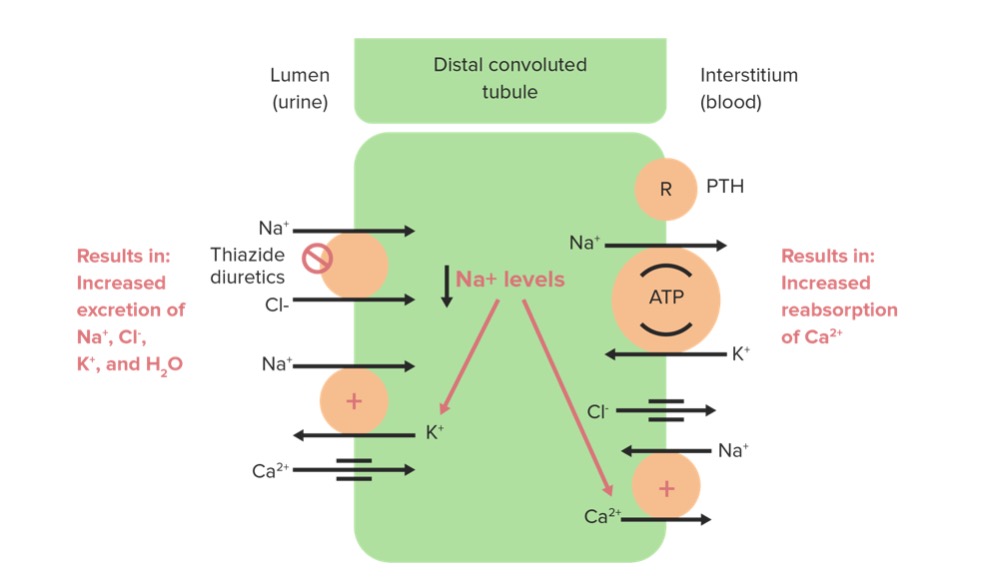Playlist
Show Playlist
Hide Playlist
Hypertension: Etiology (Humoral Blood Pressure Control Mechanisms)
-
Slides 06 VascularMedicine advanced.pdf
-
Reference List Vascular Medicine.pdf
-
Download Lecture Overview
00:00 Let’s just say a few things about the humoral mechanism. As I’ve already intimated, the humoral mechanisms – that is the hormones that are released that help control blood pressure – are also intimately connected to the central nervous system. And the kidney's again the critical factor here. 00:18 I’ve already mentioned that when blood pressure goes down or blood volume goes down, the kidney has a little volume and blood-pressure measuring system in it. And I’m going to show you a picture of that in a moment. And that system causes release of the hormone renin. And that renin, as I talked about, gets into the bloodstream, causes conversion of a chemical called angiotensinogen to angiotensin – that’s a vasoconstrictor – and also signals the adrenal to release aldosterone to hold on to salt and water for the kidney. 00:53 So the critical factor here is that we are trying to regulate blood pressure at a very even and smooth level and that, unfortunately, some people have their blood pressure regulation set at too high a level. 01:14 It’s important also to remember that this whole system is part of the body’s defence against dehydration and blood loss but, unfortunately, in a significant part of the population it’s set at too high a level. The blood pressure is excessively high and that leads to damage to the organs that we’ve talked about before. 01:37 Now this fairly complicated diagram just shows you all of the various hormonal mechanisms that are involved in regulating the blood pressure. Particularly one should pay attention to what’s on the right side there. That is the ACE pathways: that’s the angiotensin-converting enzyme pathways. 02:01 Remember, I mentioned the kidney, when it sees that there’s not enough blood pressure, releases renin. Renin gets out into the circulation and, in combination with a hormone called angiotensin-converting enzyme, it produces the very vasoconstrictive hormone angiotensin II. 02:21 So you need not only renin but you also need the so-called ACE enzyme – that angiotensin converting enzyme. And one of our most effective drugs at treating hypertension is a blocker of the angiotensin-converting enzyme. So what that means is the renin may be released but it doesn’t cause vasoconstriction because angiotensin is not produced because you’ve blocked the enzyme that’s needed for that reaction. 02:48 We can also block, at the level of these vascular smooth muscle, we can block the effect of angiotensin with an angiotensin-receptor blocker. It turns out that there’s an angiotensin-receptor blocker and there’s an angiotensin factor that increases the activity of angiotensin. 03:07 That’s angiotensin-II receptors. We’ll talk a little bit about that but the major one in control of blood pressure is angiotensin I. And I’ll show you why that is in just a moment. 03:19 I just want to say a few words about the blood-pressure measuring system within the kidney. 03:28 Within the glomerulus – which is the little filtering system in the kidney – there is a structure called the macula densa which actually monitors blood pressure in the glomerulus. 03:39 If the macula densa perceives that blood pressure is too low, it releases renin from an area called the juxtaglomerular cells. And these then are released into the circulation and, as we talked about, they get into the system, convert angiotensinogen to angiotensin. And angiotensin then is a powerful vasoconstrictor. But also renin gets to the brain and signals the sympathetic nervous system to clamp down. So all of these things are working, as you can see, to increase peripheral resistance to hold blood pressure elevated. 04:15 And, as we also said, when the renin gets to the central nervous system, it results in the pituitary releasing antidiuretic hormone – ADH, it’s also called vasopressin – and that tells the kidney, “Hold on to salt and to water.” And as you can see here all of these mechanisms – the thermostats if you will of the brain – are located in the hypothalamus. That’s the critical area of the brain for controlling the internal environment, the homeostasis environment of the body. 04:50 So let’s talk a little bit about angiotensin. 04:54 Remember, I said there were two types of receptors for angiotensin: type I and type II. Type I is the one that’s involved in high blood pressure. And we can control that by blocking the production of angiotensin with the angiotensin-converting enzyme inhibitors or we can actually block the receptor on the smooth muscle that responds to angiotensin. And those drugs are called angiotensin-receptor blockers. They do the same thing basically mechanistically. They prevent the release of renin from causing vasoconstriction. 05:33 These hormonal receptors are also activated by sympathetic nervous activity. And they also result in marked increase in renal sodium reabsorption and decreased renal blood flow when they cause vasoconstriction. So there’s a whole series of interactive mechanisms here. 05:55 But all of that is triggered by release of renin from the kidney when the receptors in the glomerulus say the blood pressure is low. 06:05 The problem with chronic stimulation of the angiotensin receptor is that it can lead to thickening of the arterioles, vascular smooth muscle cell growth. And what happens there indeed is that increases the resistance and therefore perpetuates increased peripheral vascular resistance and hypertension. High blood pressure, just like when any muscle is exercised a lot, the heart muscle gets exercised a lot when there’s high blood pressure and that causes thickening of the left ventricular wall – left ventricular hypertrophy – and this causes a whole variety of changes in the pumping ability of the heart. 06:48 Also the high blood pressure can cause damage to the glomerulus so that kidney function decreases. You can have thickening of the vascular media of the smooth muscle and that increases peripheral vascular resistance even in slightly larger arteries, even in the arterioles. 07:07 The endothelium with its release of vasodilating hormones can be impaired. That further increases peripheral resistance. You can get thickening of the intima which further increases peripheral vascular resistance. And of course hypertension is one of the factors that leads to increased atherosclerosis and stroke. And, as you know, hypertension is one of the major risk factors for atherosclerosis. 07:36 It’s also been found that the increased blood pressure in the brain eventually damages brain cells and causes dementia – that is decreased brain function. People become forgetful, confused and so forth. 07:52 Now it turns out that, as so often happens in the body, it’s like a see-saw. Every time there’s a chemical or a hormone that works one way there’s a chemical that works in the opposite direction. Or a receptor that works in the opposite direction. 08:09 The receptor that works in the opposite direction of the angiotensin-I receptor is the angiotensin-II receptor. And this receptor is involved in a number of cell activities: proliferation, or dividing of the cells; differentiation, or development of the cells; development of blood vessels, angiogenesis; wound healing; tissue repair; and cell death.
About the Lecture
The lecture Hypertension: Etiology (Humoral Blood Pressure Control Mechanisms) by Joseph Alpert, MD is from the course Arterial Diseases.
Included Quiz Questions
Renin is secreted from which of the following organ?
- Kidney.
- Pituitary gland.
- Adrenal gland.
- Endothelium of blood vessel.
- Lungs.
The humoral mechanism of blood pressure regulation is mainly controlled by which of the following organs?
- Kidney.
- Heart.
- Liver.
- Gal bladder.
- Brain.
Where in the kidney does the signaling come from that leads to renin production by the juxtaglomerular cells?
- Macula densa.
- Collecting duct.
- Ascending loop of Henle.
- Descending loop of henle.
- Renal artery.
Which of the following is the correct order of conversion and release of humoral blood pressure regulators?
- Renin-angiotensinogen-angiotensin 1.
- Renin-angiotensin 1-angiotensinogen.
- Angiotensin 1-angiotensinogen-angiotensin 2.
- Angiotensin 2- Renin- Angiotensin 1.
- Angiotensin 2- Angiotensinogen- Angiotensin 1.
AT1 receptors cause all the following when activated except?
- Vasodilation.
- Renal tubular sodium reabsorption.
- Decreased renal blood flow.
- Vasoconstriction.
- Sympathetic nervous system activation.
Customer reviews
5,0 of 5 stars
| 5 Stars |
|
5 |
| 4 Stars |
|
0 |
| 3 Stars |
|
0 |
| 2 Stars |
|
0 |
| 1 Star |
|
0 |





